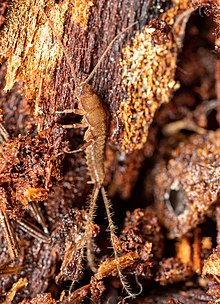Tricholepidion is a genus of wingless insect belonging to Zygentoma (silverfish and allies), with only a single described species T. gertschi, native to the northern coast of California in Western North America.[1] It lives under dead bark and in rotting wood of conifers in mesophytic forests.[2] It is alternatively considered the only living member of the family Lepidotrichidae, which also includes Lepidotrix from Eocene aged European amber, or the only member of the family Tricholepidiidae.[3] The taxonomic position of Tricholepidion is uncertain, in some molecular phylogenetics studies it has been recovered as less closely related to flying insects (Pterygota) than the rest of Zygentoma is, rendering Zygentoma paraphyletic.[1][4] Each compound eye contains ~40 ommatidia, and they have three ocelli.[1] Scales on the body are absent.[5] Unlike Archaeognatha and the other families of Zygentoma, which have three- and sometimes two-segmented tarsi, they have five-segmented tarsi like many winged insects.[6]
| Tricholepidion | |
|---|---|

| |
| Specimen seen near Cazadero, California | |
| Scientific classification | |
| Domain: | Eukaryota |
| Kingdom: | Animalia |
| Phylum: | Arthropoda |
| Class: | Insecta |
| Order: | Zygentoma |
| Family: | Lepidotrichidae |
| Genus: | Tricholepidion Wygodzinsky, 1961 |
| Species: | T. gertschi
|
| Binomial name | |
| Tricholepidion gertschi Wygodzinsky, 1961
| |
References
edit- ^ a b c Blanke, Alexander; Koch, Markus; Wipfler, Benjamin; Wilde, Fabian; Misof, Bernhard (2014). "Head morphology of Tricholepidion gertschi indicates monophyletic Zygentoma". Frontiers in Zoology. 11 (1): 16. doi:10.1186/1742-9994-11-16. ISSN 1742-9994. PMC 3975249. PMID 24625269.
- ^ Wygodzinsky, Pedro (1961-09-01). "On a Surviving Representative of the Lepidotrichidae (Thysanura)". Annals of the Entomological Society of America. 54 (5): 621–627. doi:10.1093/aesa/54.5.621. ISSN 1938-2901.
- ^ Grimaldi, David A. (March 2010). "400 million years on six legs: On the origin and early evolution of Hexapoda". Arthropod Structure & Development. 39 (2–3): 191–203. doi:10.1016/j.asd.2009.10.008. PMID 19883792.
- ^ Cucini, Claudio; Carapelli, Antonio; Brunetti, Claudia; Molero-Baltanás, Rafael; Gaju-Ricart, Miquel; Nardi, Francesco (2021-01-02). "Characterization of the complete mitochondrial genome of Neoasterolepisma foreli (Insecta: Zygentoma: Lepismatidae) and the phylogeny of basal Ectognatha". Mitochondrial DNA Part B. 6 (1): 119–121. doi:10.1080/23802359.2020.1848480. ISSN 2380-2359. PMC 7819114. PMID 33521283.
- ^ Insect Biodiversity: Science and Society, Volume 2
- ^ Evolution of the Insects
Further reading
edit- Mendes, Luís F. (2002). "Taxonomy of Zygentoma and Microcoryphia: historical overview, present status and goals for the new millennium". Pedobiologia. 46 (3–4): 225–233. doi:10.1078/0031-4056-00129.
- Mendes, Luís F. (1996). "Some new data on the Microcoryphia and Zygentoma (Insecta) from the United States". Garcia de Orta, Série Zoologia. 21 (1): 117–126. ISSN 0870-0001.